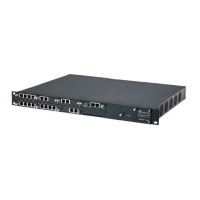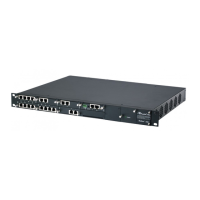User's Manual 1236 Document #: LTRT-27055
Mediant 1000B Gateway & E-SBC
Parameter Description
parameter in the Session-Expires header (sent in the
initial INVITE or subsequent 2xx response) indicates
who sends the session refresh requests. If the
parameter contains the value 'uac', the device
performs the refreshes; if the parameter contains the
value 'uas', the remote proxy performs the refreshes.
An example of the Session-Expires header is shown
below:
Session-Expires: 4000;refresher=uac
Thus, the parameter is useful when a UA does not
support session refresh requests or does not support
the indication of who performs session refresh
requests. In such a scenario, the device can be
configured to perform the session refresh requests.
[0] Remote Refresher = (Default) The UA (proxy)
performs the session refresh requests. The device
indicates this to the UA by sending the SIP
message with the 'refresher=' parameter in the
Session-Expires header set to 'uas'.
[1] SBC Refresher = The device performs the
session refresh requests. The device indicates this
to the UA by sending the SIP message with the
'refresher=' parameter in the Session-Expires
header set to 'uac'.
Note: The time values of the Session-Expires
(session refresh interval) and Min-SE (minimum
session refresh interval) headers can be configured
using the SBCSessionExpires and SBCMinSE
parameters, respectively.
User Registration Grace Time
configure voip > sbc settings > sbc-usr-reg-
grace-time
[SBCUserRegistrationGraceTime]
Defines additional time (in seconds) to add to the
registration expiry time users that are registered in the
device's Users Registration database.
The valid value is 0 to 2,000,000. The default is 0.
For more information, see Registration Refreshes on
page 653.
SBC DB Routing Search Mode
configure voip > sbc settings > sbc-db-route-
mode
[SBCDBRoutingSearchMode]
Defines the method for searching a registered user in
the device's User Registration database when a SIP
INVITE message is received for routing to a user. If
the registered user is found (i.e., destination URI in
INVITE), the device routes the call to the user's
corresponding contact address specified in the
database.
[0] All permutations = (Default) Device searches
for the user in the database using the entire
Request-
URI (user@host). If not found, it searches
for the user part of the Request-URI. For example,
it first searches for "4709@joe.company.com" and
if not found, it searches for "4709".
[1] Dest URI dependant = Device searches for the
user in the database using the entire Request-URI
(user@host) only. For example, it searches for
"4709@joe.company.com".
Note: If the Request-URI contains the "tel:" URI or

